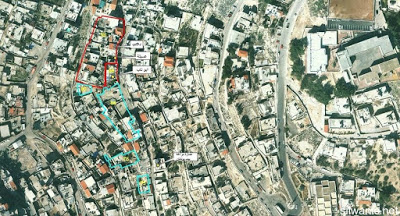 |
| Area in red shows 5 acres in middle Silwan targetted by Ateret Cohanim |
This article from Ha’aretz
shows how the Israeli government is working hand in hand with Ateret Cohanim, a
group which was established in 1978 with the express aim of the
Judaification of Jerusalem. It
specialised in buying up property or ‘reclaiming’ Jewish property from before
1948. Palestinians who live in buildings
that used to be occupied by Jews are evicted to make way for settlers, but the same principle never works in
reverse. Palestinians who want to return
to properties they owned but now occupied by Jews have no such rights. Racist laws like the Absentee Property Law
prevent even those present in the State of Israel but temporarily absent
because of hostilities from returning to their original homes.
 |
| Police guard on confiscated property |
The Western powers
are, of course aware of all this but prefer to turn a blind eye and pretend
that there is still a peace process.
are, of course aware of all this but prefer to turn a blind eye and pretend
that there is still a peace process.
Tony Greenstein
How Israel Helps Settler Group Move Jews Into East Jerusalem’s Silwan
Over the years, a government department has stood
shoulder to shoulder with Ateret Cohanim in its struggles against Palestinian
families who sought to remain in their homes.
shoulder to shoulder with Ateret Cohanim in its struggles against Palestinian
families who sought to remain in their homes.
Nir
Hasson Jan 06, 2016 2:04 PM
Hasson Jan 06, 2016 2:04 PM
In the mid-1990s, Ilan
Shtayer, a research assistant at the Ben-Zvi Institute for the study of the
Land of Israel, was asked, together with others, to conduct historical
geographical research about the Yemenite Jewish section of the Arab village of
Silwan near Jerusalem’s Old City. The team collected maps, aerial photographs
and written sources and wrote their study of the neighborhood, where Yemenites
lived from the 19th century until the riots of 1929. Among their tasks was to
locate land purchased by Jewish philanthropists to build the neighborhood for
the new immigrants from Yemen who arrived in 1882.
Shtayer, a research assistant at the Ben-Zvi Institute for the study of the
Land of Israel, was asked, together with others, to conduct historical
geographical research about the Yemenite Jewish section of the Arab village of
Silwan near Jerusalem’s Old City. The team collected maps, aerial photographs
and written sources and wrote their study of the neighborhood, where Yemenites
lived from the 19th century until the riots of 1929. Among their tasks was to
locate land purchased by Jewish philanthropists to build the neighborhood for
the new immigrants from Yemen who arrived in 1882.
As far as Shtayer
knew, the bodies commissioning the research were the Administrator General’s
office, a Justice Ministry unit responsible for selling property of various kinds
that is given to Israel, and Yad Ben-Zvi. Only after the report was completed
and the researchers met with the research steering committee, did they realize
that alongside Administrator General personnel, they found representatives of
the right-wing Ateret Cohanim organization were sitting. “I remember I was very
surprised to see them in the room,” Shtayer says.
knew, the bodies commissioning the research were the Administrator General’s
office, a Justice Ministry unit responsible for selling property of various kinds
that is given to Israel, and Yad Ben-Zvi. Only after the report was completed
and the researchers met with the research steering committee, did they realize
that alongside Administrator General personnel, they found representatives of
the right-wing Ateret Cohanim organization were sitting. “I remember I was very
surprised to see them in the room,” Shtayer says.
The research Shtayer
and his colleagues carried out was the first step in a long legal battle to
make the Silwan neighborhood of Batan el-Hawa Jewish. But it was also the
beginning of a close and unusual relationship between Ateret Cohanim and the
Administrator General. Over the years, that government department has provided
Ateret Cohanim with opinions and permits and sold the land to the association
at a convenient price, and generally stood shoulder to shoulder with Ateret
Cohanim in its struggles against Palestinian families who sought to remain in
their homes.
and his colleagues carried out was the first step in a long legal battle to
make the Silwan neighborhood of Batan el-Hawa Jewish. But it was also the
beginning of a close and unusual relationship between Ateret Cohanim and the
Administrator General. Over the years, that government department has provided
Ateret Cohanim with opinions and permits and sold the land to the association
at a convenient price, and generally stood shoulder to shoulder with Ateret
Cohanim in its struggles against Palestinian families who sought to remain in
their homes.
After the 1990s
research was used to map Jewish properties in Silwan, the next phase was for
Ateret Cohanim to take possession of the historical hekdesh – the association
that purchased the property in the 19th century and legally speaking is still
the owner. The turning point was in 2001, when the Jerusalem District Court
approved the appointment of three new individuals as trustees of the hekdesh:
M., who works for Ateret Cohanim, taking care of details involving the
evacuation of Palestinian families; A., a lawyer representing the association,
and Y., a well-known rabbi in Jerusalem who is close to Ateret Cohanim. The
Administrator General supported Ateret Cohanim’s application for their people
to be appointed trustees.
research was used to map Jewish properties in Silwan, the next phase was for
Ateret Cohanim to take possession of the historical hekdesh – the association
that purchased the property in the 19th century and legally speaking is still
the owner. The turning point was in 2001, when the Jerusalem District Court
approved the appointment of three new individuals as trustees of the hekdesh:
M., who works for Ateret Cohanim, taking care of details involving the
evacuation of Palestinian families; A., a lawyer representing the association,
and Y., a well-known rabbi in Jerusalem who is close to Ateret Cohanim. The
Administrator General supported Ateret Cohanim’s application for their people
to be appointed trustees.
Haaretz is still
waging a legal battle, which went all the way to the Supreme Court, to have a
gag order lifted on the names of the individuals in question; the court
approved their request to keep their names confidential because revealing them
could put them in danger.
waging a legal battle, which went all the way to the Supreme Court, to have a
gag order lifted on the names of the individuals in question; the court
approved their request to keep their names confidential because revealing them
could put them in danger.
A year after the
District Court’s ruling, the new trustees asked the government’s administrator
of properties to release land to the hekdesh. The administrator approved the
request and transferred to the hekdesh 5.5 dunams (about 1.3 acres) in the
heart of Silwan, where hundreds of Palestinians live. Ateret Cohanim then
launched the legal process to evict the Palestinian families.
District Court’s ruling, the new trustees asked the government’s administrator
of properties to release land to the hekdesh. The administrator approved the
request and transferred to the hekdesh 5.5 dunams (about 1.3 acres) in the
heart of Silwan, where hundreds of Palestinians live. Ateret Cohanim then
launched the legal process to evict the Palestinian families.
A year ago, in an
effort to remove all doubt, the deputy head of the office of the administrator
of absentee property, Sigal Ya’akobi, signed another document releasing the
land to the three trustees. This time, the precise lots are mentioned: 95 and
96, according to official Israeli land records.
effort to remove all doubt, the deputy head of the office of the administrator
of absentee property, Sigal Ya’akobi, signed another document releasing the
land to the three trustees. This time, the precise lots are mentioned: 95 and
96, according to official Israeli land records.
But the
administrator’s most problematic decision was to sell four other lots to the
hekdesh that were not part of its original land. This happened in 2005, when
the administrator realized that the original owners could not be located. The
land, almost 2,000 square meters, was sold for 995,825 shekels ($253, 240).
administrator’s most problematic decision was to sell four other lots to the
hekdesh that were not part of its original land. This happened in 2005, when
the administrator realized that the original owners could not be located. The
land, almost 2,000 square meters, was sold for 995,825 shekels ($253, 240).
Why did a right-wing
group receive the right to purchase the property in the densely populated heart
of Silwan, at such a low price and without a tender? According to law, the
administrator must give priority in selling property to individuals in
possession of or living in nearby assets. But a glance at the map shows that
two of the lots are not adjacent to the hekdesh and are surrounded on all sides
by Palestinian lands. Two other lots owned by the hekdesh are adjacent to it
only on one side, meaning that three or four neighbors other than the hekdesh
could be potential purchasers – but they were not given the opportunity to do
so because the administrator did not publish a tender.
group receive the right to purchase the property in the densely populated heart
of Silwan, at such a low price and without a tender? According to law, the
administrator must give priority in selling property to individuals in
possession of or living in nearby assets. But a glance at the map shows that
two of the lots are not adjacent to the hekdesh and are surrounded on all sides
by Palestinian lands. Two other lots owned by the hekdesh are adjacent to it
only on one side, meaning that three or four neighbors other than the hekdesh
could be potential purchasers – but they were not given the opportunity to do
so because the administrator did not publish a tender.
Regular property
costs in Silwan show what a low price Ateret Cohanim paid. According to records
of the Tax Authority, an average apartment in Silwan goes for 1.2 million
shekels. In 2005 prices were significantly lower, but according to experts,
they have not changed as drastically as in the western part of town and the
rest of the country.
costs in Silwan show what a low price Ateret Cohanim paid. According to records
of the Tax Authority, an average apartment in Silwan goes for 1.2 million
shekels. In 2005 prices were significantly lower, but according to experts,
they have not changed as drastically as in the western part of town and the
rest of the country.
According to a
Justice Ministry statement released in the name of the Administrator General’s
office, the price Ateret Cohanim paid is higher than the value determined by a
real estate assessor.
Justice Ministry statement released in the name of the Administrator General’s
office, the price Ateret Cohanim paid is higher than the value determined by a
real estate assessor.
The administrator did
not deny that no tender had been issued and gave no explanation for this, or
for the fact that preference was given to Ateret Cohanim.
not deny that no tender had been issued and gave no explanation for this, or
for the fact that preference was given to Ateret Cohanim.
The Duweik family,
one of those living in hekdesh property, has been waging various legal battles
against Ateret Cohanim. The family has so far lost in the Jerusalem District
Court and the Supreme Court in a suit brought by Ateret Cohanim against illegal
construction the family carried out, and Ateret Cohanim is now suing to have
the family evicted.
one of those living in hekdesh property, has been waging various legal battles
against Ateret Cohanim. The family has so far lost in the Jerusalem District
Court and the Supreme Court in a suit brought by Ateret Cohanim against illegal
construction the family carried out, and Ateret Cohanim is now suing to have
the family evicted.
One of the family’s
attorneys, Hussam Siam, says the administrator’s conduct shows the close
connections with Ateret Cohanim. The court had ordered the administrator to
allow the family’s legal team access to all documents, Siam says. “But when we
came to the administrator’s office, their representatives and Ateret Cohanim
people were sitting there and every important document we wanted to see they
said, ‘no, that’s forbidden, that’s confidential.’”
attorneys, Hussam Siam, says the administrator’s conduct shows the close
connections with Ateret Cohanim. The court had ordered the administrator to
allow the family’s legal team access to all documents, Siam says. “But when we
came to the administrator’s office, their representatives and Ateret Cohanim
people were sitting there and every important document we wanted to see they
said, ‘no, that’s forbidden, that’s confidential.’”
Jerusalem District
Court Judge Aharon Farkash dismissed that argument, saying that the family
should have subpoenaed the administrator’s employees to cross-examine them about
it.
Court Judge Aharon Farkash dismissed that argument, saying that the family
should have subpoenaed the administrator’s employees to cross-examine them about
it.
Attorney Mohammad
Dahla, who represents Palestinian families in Silwan, and other lawyers have
identified a number of ways to take over property in East Jerusalem that had
belonged to Jews before 1948. Appointing trustees to hekdesh property is one
way. Another, used in the East Jerusalem neighborhood of Sheikh Jarrah, is to
locate the Jewish heirs to various properties, have them sign power of attorney
over to the association and approach the administrator’s office in the name of
the heirs with a request to release the property. The association then
purchases it from the Jewish family, and moves people in. In most cases,
right-wing activists play “matchmaker” between the heirs and donors from abroad
who purchase it from them.
Dahla, who represents Palestinian families in Silwan, and other lawyers have
identified a number of ways to take over property in East Jerusalem that had
belonged to Jews before 1948. Appointing trustees to hekdesh property is one
way. Another, used in the East Jerusalem neighborhood of Sheikh Jarrah, is to
locate the Jewish heirs to various properties, have them sign power of attorney
over to the association and approach the administrator’s office in the name of
the heirs with a request to release the property. The association then
purchases it from the Jewish family, and moves people in. In most cases,
right-wing activists play “matchmaker” between the heirs and donors from abroad
who purchase it from them.
A third method is for
right-wing activists to approach the administrator’s office directly to request
that a property be sold to them. The Custodian of Absentee Property in the
Finance Ministry and the Administrator General in the Justice Ministry have
sold dozens of properties in East Jerusalem over the years, many of them to
groups working to settle Jews in East Jerusalem.
right-wing activists to approach the administrator’s office directly to request
that a property be sold to them. The Custodian of Absentee Property in the
Finance Ministry and the Administrator General in the Justice Ministry have
sold dozens of properties in East Jerusalem over the years, many of them to
groups working to settle Jews in East Jerusalem.
“The deep involvement
of the Administrator General and the authorities in transferring assets in
Silwan to settlers pulls the rug out from under the government’s claim that
these are merely private real-estate dealings,” says Hagit Ofran of Peace Now.
of the Administrator General and the authorities in transferring assets in
Silwan to settlers pulls the rug out from under the government’s claim that
these are merely private real-estate dealings,” says Hagit Ofran of Peace Now.
The Justice Ministry
spokeswoman said the administrator general “does not manage documentation about
the tenants. An amended release certificate was issued at the request of the
hekdesh trustees based, among other things, on the opinion of a licensed
surveyor… The matter received further validation from the District Court.”
spokeswoman said the administrator general “does not manage documentation about
the tenants. An amended release certificate was issued at the request of the
hekdesh trustees based, among other things, on the opinion of a licensed
surveyor… The matter received further validation from the District Court.”
In contrast to the
Duweik family’s attorneys’ claim, the spokeswoman said that “in the framework
of the legal proceedings the parties were given the opportunity to examine the
administrator general’s file.”
Duweik family’s attorneys’ claim, the spokeswoman said that “in the framework
of the legal proceedings the parties were given the opportunity to examine the
administrator general’s file.”
As for the sale of
properties to the hekdesh, the Justice Ministry spokeswoman said the lots were
offered for sale “a decade ago in light of their planning and legal status…
while maintaining the broader interests of the owners of the lots.”
properties to the hekdesh, the Justice Ministry spokeswoman said the lots were
offered for sale “a decade ago in light of their planning and legal status…
while maintaining the broader interests of the owners of the lots.”
Attorney Avraham
Moshe Segal, who represents the hekdesh, said: “Haaretz readers should know
that the Supreme Court issued a gag order prohibiting Haaretz from published
details that could identify those involved in the purchases in Silwan. Haaretz
should bow its head and respect the court’s verdict.”
Moshe Segal, who represents the hekdesh, said: “Haaretz readers should know
that the Supreme Court issued a gag order prohibiting Haaretz from published
details that could identify those involved in the purchases in Silwan. Haaretz
should bow its head and respect the court’s verdict.”
Segal also noted that
“four District Court judges noted that the hekdesh is the legal owner of the
hekdesh land. This was approved by four Supreme Court justices. All claims by
Haaretz were rejected in verdicts of the Supreme Court, a fact that does not
stop the newspaper from thinking, mistakenly, that it is a judicial tribunal
serving as a court of appeals over the Supreme Court.”
“four District Court judges noted that the hekdesh is the legal owner of the
hekdesh land. This was approved by four Supreme Court justices. All claims by
Haaretz were rejected in verdicts of the Supreme Court, a fact that does not
stop the newspaper from thinking, mistakenly, that it is a judicial tribunal
serving as a court of appeals over the Supreme Court.”
Nir Hasson
Nir Hasson
Haaretz Correspondent
Posted in Blog


